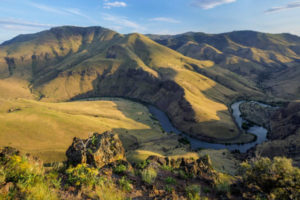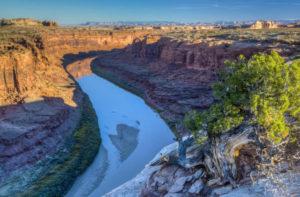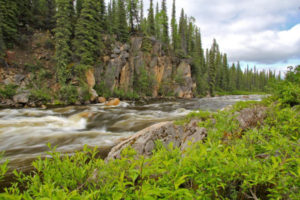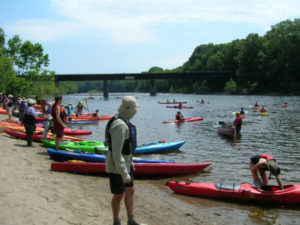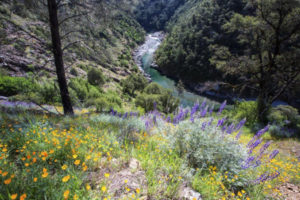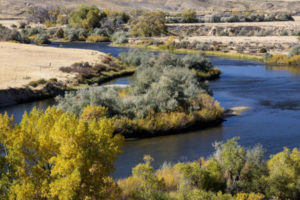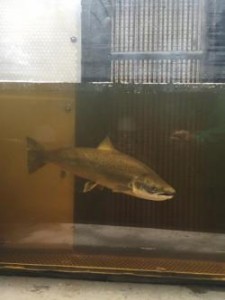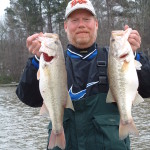Smallmouth Stories
October 14, 2024
You never know when or where you’ll connect with the fish of a lifetime

PARK FALLS, Wis. (October 9, 2024) – Sometimes referred to as “a foot deep and a mile wide,” the sprawling Susquehanna River rises in Central New York’s Otsego Lake and drains over 27,000 square miles in three states before dumping into the Upper Chesapeake Bay. Bisecting the entire state of Pennsylvania and containing a rich forage base, the Susky is full of spunky smallmouth bass… for anglers who can get to them.
Shallow and rocky, the Susquehanna is the domain of the jetboat; ideal craft for skimming over and around treacherous rocks and ledges that would destroy an ordinary bass boat. Susquehanna fishing guide, Joe Raymond, bought his first in his twenties and now runs a 300-HP Rock Proof River Rocket. He’s been guiding anglers on the Susquehanna for over 15 years. In that time, he watched his clients catch a lot of big bass. A couple of weeks ago, Raymond caught one of his own.
Along with tournament partner and fellow guide, Tom Mills, the St. Croix Rod and Z-Man ambassador recently accounted the entire story to Susquehanna Fishing Tackle owners, brothers Mike and George Acord, on their Tackle Shop Live podcast.
“For George and me, we looked at this picture and were absolutely shellshocked,” Mike told viewers in his intro. That speaks volumes, given the Acord brothers’ some-50 years of experience fishing on the Susquehanna River, not to mention the hundreds of big smallmouth photos they see from their customers each and every year.
Raymond described the series of events leading up to the historic catch.
“Tom (Mills) and I had talked about fishing a Williamsport Bassmasters Charity Tournament for Toys for Tots,” Raymond said. “We’d only fished up there a couple times and it had been a few years. We remembered both times being a dinkfest, but we decided to do it and have some fun while supporting a worthy cause. There was a big thunderstorm the night before. My roof was leaking and I didn’t sleep at all. We didn’t have much of a gameplan and just headed upriver in the dark to a spot we’d had some success at before. There was already a boat there so we just kept going.”
Raymond says they finally pulled into a spot and started fishing. “The plan was for me to fish for a limit and Tom to target a lunker,” he recalls. “I was throwing a 3” Z-Man MinnowZ swimbait on a weedless jighead and I kept losing fish. Nothing big, but it was aggravating,” he says. When Raymond opted to switch to an open jig, a new sort of misery crept in. “I started to catch a few small ones, but I was getting snagged on almost every cast. I told Tom I was done and we had to move.”
The pair bounced around to a few spots in the largely unfamiliar water without a lot of success. “There was an area up there in one of those pools we had passed… it looked so good,” Raymond says. “We agreed it had to have fish, but we’d never caught anything there during our two prior trips to this part of the river. We decided to try it anyway.”
The pair arrived at the back end of the pool and Raymond started fishing his 3” MinnowZ on a 7’ medium-power St. Croix Legend X spinning rod paired to a 3000 Vanford reel with10-lb. smackdown braid and a 10-lb. Tatsu fluoro leader. The curse continued. “I broke off again… like right away… and had to tie on a whole new leader,” Raymond says. “Tom was throwing a Ned rig in a current seam and he had broken off too.”

Raymond was sick of snagging up, so he tied a fresh EZ Money-colored Z-Man paddletail with a weedless jighead onto the fresh leader.
“There was a log on the bottom in the back of this pool in about four feet of water. I made a cast to it and flipped the bail closed after giving the bait a couple seconds to get down,” Raymond says. “I reeled tight and felt weight and immediately thought I was snagged again… then I felt movement. I hit this thing and it came screaming up and did a backflip in front of the boat. The fish looked huge, but I was still trying to process what had happened and how big the bass actually was. It only took a couple more seconds before I realized what I was fighting.”
“When a guy like Joe Raymond tells you to get the net because he just hooked the biggest smallmouth of his life, you move quickly,” Mills says. “The fish was just digging behind the boat puking up crayfish like crazy. The water was so clear it was like watching the scene in an aquarium.”
“The fish fought so hard,” Raymond says. “I was thinking, is this real life?” Then the St. Croix took a deeper bend and the fish took off downstream.
Raymond snapped out of his daydream and took the MinnKota off of Spotlock to follow the big brown bass that was now peeling line and headed for some rapids. “We caught up and netted it,” Raymond says. “Both of us were staring into the net and going crazy like a couple little kids.”
Raymond weighed and measured the fish quickly before snapping a couple of photos. She stretched the tape to 24 inches and bottomed out at 7.19 pounds. Later, the fish would weigh 7.08 at the tournament weigh in.
“I just kinda lost it,” Raymond says. “Like any guide – or any serious fisherman – I obsess over big fish. I’ve celebrated with so many of my clients after helping them catch personal-best bass over the years. This fish is the first over six pounds I’ve ever caught on the Susquehanna, and only the second over seven anyone I know has ever heard of from the river. It wasn’t a super-fat fish, just thick all the way through and super healthy. I actually know the guy who caught the other documented 7-1 back in 1981. His name is Russell Fuller. I heard the story over and over when I was young and was always suspect until I got the chance to meet him and speak with him later in life. He brought the mount into the restaurant a few years ago and I was blown away when I saw it. He caught his in the spring, basically right behind the house where I now live in Duncannon. It was a 23” pre-spawn fish, so it was quite a bit fatter. Mine wasn’t as deep but was an inch longer.”
Raymond has a few key tips for all smallmouth anglers.
“You never know when or where you’ll connect with the fish of a lifetime,” he says. I certainly never expected to run into this fish in the spot we were fishing. I was lucky that I had just re-tied my leader. We’ve all gotten lazy about knots and leaders and it always bites you. I learned this early as a guide. If you cinch down a knot and it doesn’t feel right, or your leader knot gets hung up in your guides, or you feel some nicks in your leader, take the time to re-tie and avoid disappointment.”
Raymond is also a firm believer in using the best gear you can afford. “I’m not rod heavy; I’m rod particular,” he says. “Unlike a lot of bass fishermen who have a dedicated rod for every specific presentation they make, I’m the guy who has a handful of different rods that I like and trust with a few powers and actions that suit the lines and lures I most often fish. There are a ton of great rods on the market today. For me, it’s hard to beat the quality and performance of St. Croix and specifically their Legend X series. These rods are made in the USA, light, load up great, and are extremely sensitive. It’s the same with the lures I most often use. Z-Man ElaZtec plastics mimic everything in this river a smallmouth eats and the material is incredibly soft with unmatched durability. For me, that means my clients can catch a bunch of fish on a single bait before I have to replace it. The Z-Man MinnowZ swimbait is the best bait ever for guiding. They can be rigged in a bunch of different ways to match the conditions and have a shimmy almost like a spybait on a slow steady retrieve. You will catch fish hopping them on the bottom and burning them through the water, too.”
Finally, Raymond encourages anglers to handle all fish with care and to release the ones with the genetics that make better fishing possible for everyone. “I think most bass anglers are in the same camp about caring for big bass and releasing them healthy, but we still have some archaic regulations and procedures in some states, especially when it comes to recognizing record fish,” he says. “In a lot of states, you just can’t get a record fish certified without killing it. No record or recognition is worth killing a huge, old fish. The very same day I caught my fish here in Pennsylvania, a guy fishing a tournament in New York caught a nine-pounder, which would have smashed the state record. He called the DEC and was told to put the fish on ice until someone could come out and certify the fish the next day. He would have had to kill it to get it certified. That’s a huge problem. To his credit, the angler – Dante Piraino – knew better and had no part of that plan. After it was weighed and revived, he adamantly directed tournament officials to put that fish right back into the St. Lawrence River with all the rest of them. States need more protocols and procedures that make it easy for people to certify fish like this without killing the fish. These are genetic freaks and all of us need to let them continue to do their thing.”
Contact Joe Raymond or book a trip with him through his website, susquehannasmallmouthguides.com. Follow him on Instagram and Facebook.
For up-to-date information on fishing in the Susquehanna River, or for tackle recommendations, contact Susquehanna Fishing Tackle at 800-814-7433 or via their website, sfttackle.com.
